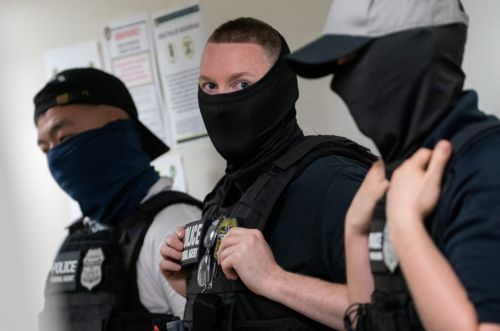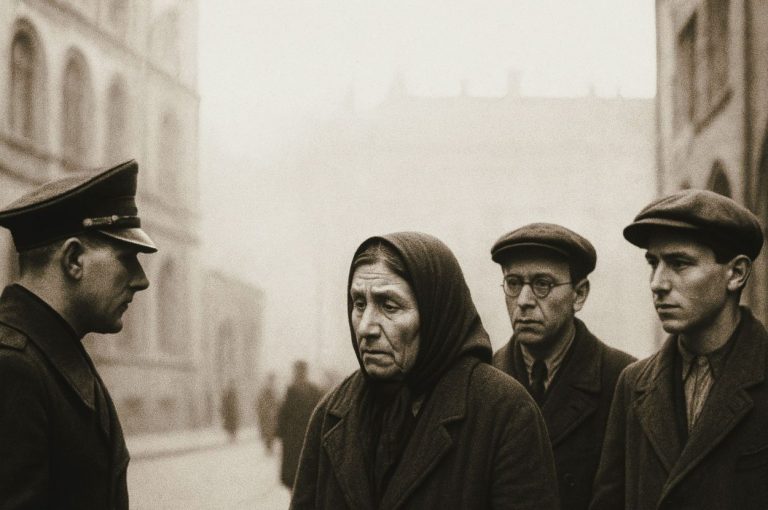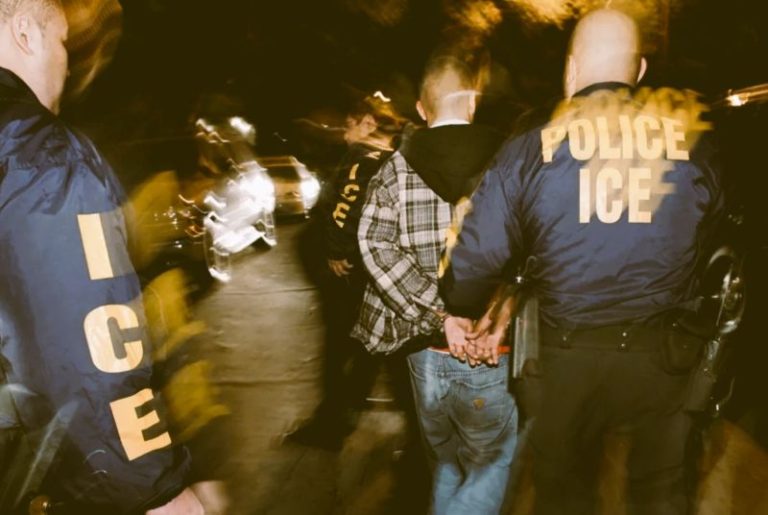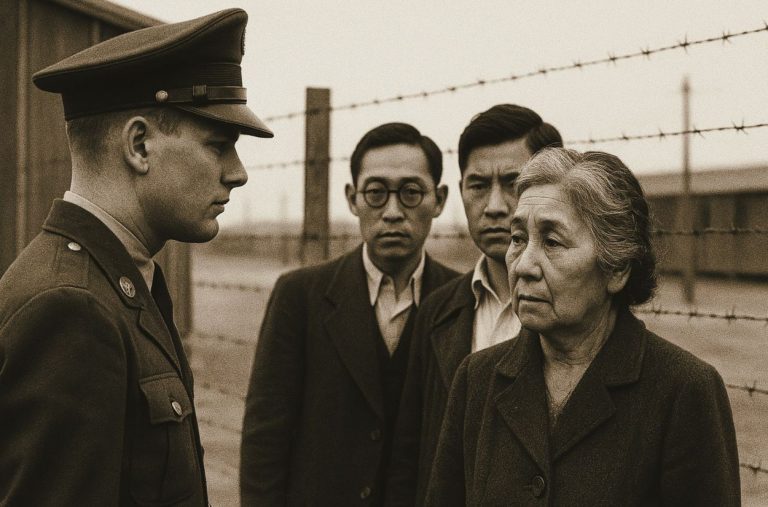

In legal terms, the outcome of ongoing court challenges will determine whether ICE’s mask policy endures or collapses under constitutional scrutiny.

By Matthew A. McIntosh
Public Historian
Brewminate
Introduction
In cities across the United States, Immigration and Customs Enforcement (ICE) agents in masks and tactical vests have become a familiar and unsettling presence. Backed by the Trump administration’s revived mandate for “maximum enforcement,” these teams are conducting high-profile raids that have swept up undocumented immigrants and, in several cases, U.S. citizens. There are scenes of masked men lining courthouse corridors in New York, their faces hidden behind sunglasses and caps, projecting what one journalist described as a “paramilitary image.” Civil rights advocates say that image reflects a deeper reality, an agency operating with growing impunity, eroding the line between lawful arrest and abduction.
Background and Context
The Trump administration’s second term has brought a renewed campaign of immigration crackdowns under the banner of “restoring order.” In major cities like Chicago, there have been waves of raids carried out by heavily armed ICE teams working in coordination with National Guard deployments. Officials defend the operations as efforts to “remove dangerous aliens,” but civil rights groups and local leaders describe them as political theater designed to intimidate immigrant communities and assert federal control over Democratic-led regions.
ICE spokespeople have said that agents wear masks to protect their identities from “doxxing and targeted harassment.” But critics argue that such anonymity invites abuse. The Le Monde investigation found that masked ICE units have conducted arrests at courthouses, schools, and apartment complexes, often without identifying themselves or presenting warrants. Legal experts warned that the practice echoes the extrajudicial tactics of secret police, eroding transparency and accountability within domestic law enforcement.
At the heart of the controversy lies a constitutional question: when officers conceal their identities, how can citizens verify who they are or hold them responsible for misconduct? That question now defines the public debate over ICE’s role in Trump’s immigration policy and the broader moral reckoning over state power in the United States.
Recent Incidents and Allegations
Reports of masked ICE agents detaining people without clear identification or warrants have multiplied across the country. In Chicago, there were a series of predawn raids that left families terrified and local officials demanding explanations after several residents, including a naturalized U.S. citizen, were allegedly taken from their homes without notice. Witnesses said agents wore black tactical gear and full-face coverings, refusing to answer questions about who they were or where detainees were being taken.
In Oregon, Representative Janelle Bynum demanded an immediate halt to ICE raids after a U.S. citizen was allegedly abducted by masked agents outside a grocery store. “If these reports are true,” she said in a public statement, “this is not law enforcement; it’s state-sponsored kidnapping.” Her call echoed growing outrage from immigrant-rights advocates and attorneys, who warn that the agency’s actions are blurring the line between federal authority and vigilantism.
International outlets have also taken note. Le Monde chronicled a pattern of “masked arrests” in major American cities, citing testimony from lawyers who say detainees were transferred without records or contact information. In several cases, families only discovered their relatives’ locations days later through legal aid organizations. Civil rights lawyers have compared the pattern to the secretive “black sites” once associated with counterterrorism operations, warning that the tactics are now being turned inward, against residents and citizens alike.
Official Statements and Pushback
The Department of Homeland Security has defended the masked operations as a necessary precaution. In statements to multiple outlets, ICE officials said agents began covering their faces after a rise in online harassment and threats to their families, insisting that the tactic “does not interfere with the lawful execution of immigration enforcement.” Yet those assurances have done little to calm the backlash from lawmakers, civil liberties groups, and local governments who say the policy undermines the rule of law itself.
Representative Bynum renewed her call for congressional hearings, warning that “Americans deserve to know who is being taken, under what authority, and by whom.” Across the political spectrum, legal experts have voiced alarm over what they see as the quiet normalization of unidentifiable federal force. The New York City Bar Association issued a statement condemning the practice, saying that “masking agents engaged in civil enforcement transforms an administrative action into something indistinguishable from an abduction.”
The American Civil Liberties Union has gone further, accusing ICE of “operating as a clandestine arm of political repression.” In a press release, the organization argued that masked arrests make it “impossible for victims of abuse to identify perpetrators or for oversight bodies to verify conduct.” Immigration attorneys have begun filing habeas petitions demanding the release of detainees whose arrests were carried out by masked agents, citing violations of due process and unlawful detention standards.
Legal and Accountability Issues
The masked-agent tactic occupies a legal gray zone that courts are now actively scrutinizing. The New York City Bar Association has warned that by concealing officers’ identities, ICE may be circumventing core protections of due process and accountability. They point out that 8 C.F.R. § 287.8 requires that an immigration officer, “as soon as it is practical and safe to do so,” must identify themselves as an authorized arresting officer. The Bar argues that masking wholesale undermines that regulatory duty.
The risk of impersonation compounds the problem. The Bar noted that in some communities, anonymous agents create confusion over who is a genuine officer and who might be a fraud or vigilante.
Litigation is underway. In Southern California, immigrant-rights groups and local governments have sued to limit ICE’s operations. One complaint targets “roving patrols” allegedly making warrantless detentions based on race, appearance, or location rather than individualized probable cause.
In fact, a U.S. District Judge granted a temporary restraining order stopping agents from conducting stops unless they have “reasonable suspicion” of immigration violations. The order also requires detainees be given access to counsel. The judge criticized sweeping tactics relying on race, language, or location as indicators, calling them violations of the Fourth and Fifth Amendments.
At the federal level, Senators Mark Warner and Tim Kaine have formally pushed ICE to adhere to existing rules mandating self-identification and limiting mask use, requesting internal ICE policies, memoranda, training materials, and legal guidance on these practices.
On the legislative front, House Democrats have introduced the No Secret Police Act, which would ban ICE agents from wearing masks or face coverings that obscure identity during immigration enforcement (with narrow exceptions for safety). The bill would require agents to display clear identification in nearly all operations.
In California, the state attorney general and governor have intervened in litigation and policy debates. Attorney General Rob Bonta has criticized ICE and CBP for using mask tactics that, in his view, “vanish people to meet indiscriminate arrest quotas” and terrorize communities.
Still, major obstacles remain. The federal government contends that states lack authority to regulate the conduct of ICE agents. Mask bans or identification mandates imposed by states could face constitutional challenges as interfering with federal enforcement authority. Moreover, many ICE operations are justified under national security or tactical protection claims, which officials argue may require anonymity in certain cases.
Nevertheless, the legal fights now unfolding represent more than symbolic resistance. They may define the parameters of how far anonymity in federal enforcement may extend or whether enforcing law in public demands visible accountability.
Public Reaction and Community Response
Across the country, outrage over the masked ICE raids has fueled protests and community defense networks reminiscent of the early sanctuary-city movements. In Chicago and Los Angeles, demonstrators have gathered outside federal courthouses carrying signs reading “Unmask ICE” and “Where Are They Taking Our Neighbors?” Local immigrant-rights groups have begun training residents to document encounters and verify credentials before cooperating with anyone claiming to be a federal officer.
In Washington, D.C., there are neighborhoods where residents have plastered walls and bus stops with posters declaring, “ICE Kidnapped Someone Here.” Activists say the signs are both memorials and warnings — part of a grassroots campaign to track disappearances and demand transparency from federal agencies. “These raids create terror by design,” said one organizer with Movimiento Cosecha, “but they’ve also created resistance.”
Local governments in New York, Illinois, and California have issued statements refusing to cooperate with masked federal agents. Several city councils have passed resolutions condemning ICE’s tactics and urging Congress to restrict unidentifiable enforcement actions within their jurisdictions. The Le Monde report noted that even some police departments have privately expressed discomfort, saying the federal raids risk undermining trust between local officers and immigrant communities.
Civil rights attorneys are coordinating pro bono legal aid for families searching for detained relatives, often without official confirmation of custody. Social media campaigns using hashtags like #UnmaskICE and #WhereIsMyFamily have amplified individual stories — a citizen detained outside a store, a father missing after a traffic stop, a young woman taken from a bus terminal. These personal accounts, verified by journalists and attorneys, have become a public ledger of fear and defiance.
The cumulative effect has been a rare moment of bipartisan civic unease. Even some conservative commentators have questioned the optics of federal agents arresting citizens in masks.
Conclusion and Implications
The sight of masked agents pulling citizens into unmarked vans has become one of the most haunting symbols of Trump’s second-term immigration policy, a government force operating behind anonymity. What began as an administrative measure to “protect agents from harassment” has metastasized into a defining moral question about power in a democracy: can a free nation tolerate law enforcement that hides its face from the public it serves?
Civil libertarians argue that this is not simply an immigration issue, but a constitutional one, a slow-motion erosion of accountability that blurs the distinction between the rule of law and the rule of fear. The Le Monde investigation described the raids as “a theater of power designed to intimidate,” while the New York City Bar Association warned of a “normalization of repressive tactics” within civil enforcement. Even allies of the administration have conceded that ICE’s visibility crisis threatens to deepen mistrust in federal institutions already under strain.
In legal terms, the outcome of ongoing court challenges will determine whether ICE’s mask policy endures or collapses under constitutional scrutiny. But politically, the damage may already be done. The image of faceless agents seizing both migrants and citizens (untraceable, unaccountable, and unrepentant) has pierced the national conscience. It evokes the darker lessons of history, when governments cloaked repression in legality and patriotism.
For many Americans, the question is no longer abstract. It’s not just who is being taken, but what kind of country allows it.
Originally published by Brewminate, 10.14.2025, under the terms of a Creative Commons Attribution-NonCommercial-NoDerivatives 4.0 International license.


